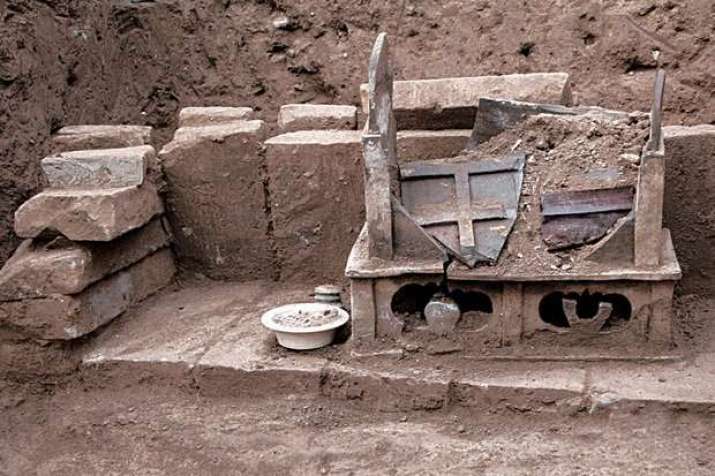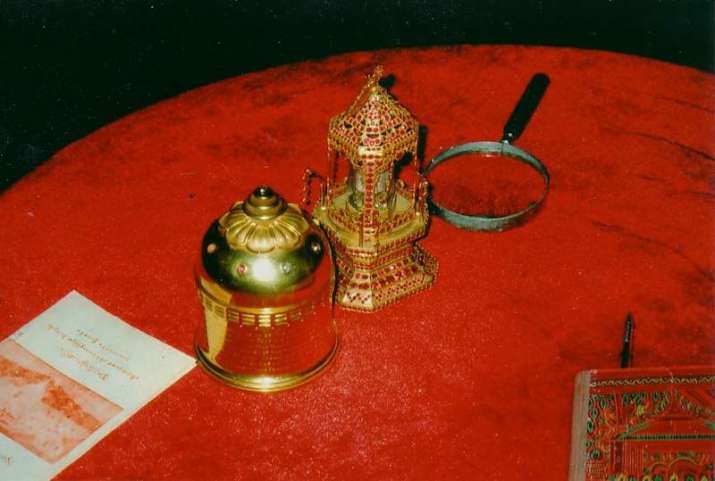NEWS
Cremated Remains Claimed to Belong to the Buddha Discovered in Chinese Village
 Ceramic box with a nearby inscription claiming it to store relics. From Chinese Cultural Relics
Ceramic box with a nearby inscription claiming it to store relics. From Chinese Cultural RelicsDetails of a casket with cremated remains, claimed to belong to the Buddha, found at Gongchi Village in Jingchuan County, China, were revealed to the public on 14 November. The remains were interred on 22 June 1013, as claimed by the inscription on the casket.
Gongchi villagers first discovered the casket and 260 statues depicting the Buddha, bodhisattvas, and arhats in December 2012, while repairing roads in the area. Archeologists excavated the artifacts in 2013, and in 2016 the academic journal Wenwu published a study on the statues, with an English translation appearing in Chinese Cultural Relics. The statues were built between the Northern Wei Dynasty (386–534) and the Song Dynasty (960–1279), with some reaching 6.6 meters in height. The statues range from just heads to full body sculptures and steles. (LiveScience)
An inscription on the casket states: “The monks Yunjiang and Zhiming of the Lotus School, who belonged to the Manjushri Temple of the Longxing Monastery in Jingzhou Prefecture, gathered more than 2,000 pieces of śarīra (cremated remains of the Buddha) as well as the Buddha's teeth and bones, and buried them in the Mañjuśrī Hall of this temple." (LiveScience) Remains of a structure that could have been part of the long-lost Mañjuśrī Hall were also discovered.
The Gongchi inscription, interestingly, does not seem particularly confident or convinced of the authenticity of the casket’s bodily remains. Rather, it seems to express the genuine piety of Yunjiang and Zhiming as virtues in themselves. It continues: "In order to promote Buddhism, they wanted to collect śarīra [relics of the Buddha]. To reach this goal, both of them practiced the instruction of Buddhism during every moment of their lives for more than 20 years. . . . Sometimes they received the śarīra from others' donations; sometimes they found them by chance; sometimes they bought them from other places; and sometimes others gave them the śarīra to demonstrate their wholeheartedness." (LiveScience)
 Relics from the Kanishka Reliquary in Peshawar, Pakistan, now in Mandalay, Myanmar. From Teresa Merrigan
Relics from the Kanishka Reliquary in Peshawar, Pakistan, now in Mandalay, Myanmar. From Teresa MerriganThe Buddha’s relics (Pali: cetiya) have been a fabled collection of holy treasures since the most ancient period of Buddhism, from the day the Buddha entered Parinirvana. When Siddhartha Gautama, Shakyamuni Buddha, died around 483 BCE or 400 BCE (depending on which dating system one uses), his body was cremated on a sandalwood pyre in Kushinagar. Several gleaming, indestructible body parts were left behind, entrusted to the Indian kings and princes present at the Buddha’s funeral, and consequently scattered across the subcontinent and the world.
Today, purported parts of the Buddha’s cremated body reside in major temples scattered across the world, such as the Temple of the Sacred Tooth Relic in Kandy, Sri Lanka (which houses the left canine tooth (danta dhātuya) of the Buddha). Relics were also found in reliquaries like the Bimaran and Kanishka caskets, which were discovered in Jalalabad, Afghanistan and Peshawar, Pakistan respectively. This is not to say that purported relics of Shakyamuni Buddha don’t show up even today; in 2016 a skull bone housed inside a lavish reliquary made of sandalwood, silver, and gold and covered with gemstones made from crystal, glass, agate, and lapis lazuli was discovered in a crypt beneath the ruins of the Grand Bao En Temple in Nanjing. (LiveScience)
Not all Buddhist relics are related to the historical Buddha, they can also belong to Buddhist saints and great teachers, and even Buddhas of previous cosmic cycles—the Shwedagon Pagoda in Yangon in Myanmar, for example, is said to house the relics of the four Enlightened Ones preceding the historical Buddha.
See more
Cremated Remains of the 'Buddha' Discovered in Chinese Village (LiveScience)
Preliminary Understanding of the Newly Discovered Hoard of Buddhist Statues From Jingchuan County (Chinese Cultural Relics)
Ancient Shrine That May Hold Buddha's Skull Bone Found in Crypt (LiveScience)
Related news from Buddhistdoor Global
Pakistan Sends Sacred Buddhist Relics to Sri Lanka for Vesak Festival
Related features from Buddhistdoor Global
Sacred Stupas and Precious Pagodas: The Many Roles of Reliquaries in the Buddhist Landscape














